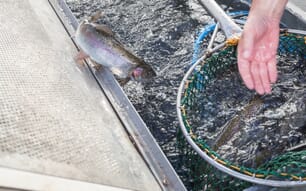
For her doctorate at the Norwegian School of Veterinary Science, Hege Smith Tunsjø studied the winter ulcer, a disease that affects farmed salmon and rainbow trout, and it causes great losses in the farming industry. It is predicted that the results from her work will contribute to better vaccines and fewer outbreaks of the disease in the farming localities. The bacterium Moritella viscosa is regarded as the main causative agent of winter ulcer and Dr Tunsjø shows how environmental factors such as temperature and salt might have a significant influence on the ability of the bacteria to cause disease.
Winter ulcer affects Norwegian farmed fish in cold marine waters, mainly farmed Atlantic salmon and farmed rainbow trout. The disease can be acute, with a high level of mortality, or it can demonstrate more chronic characteristics with wounds covering large parts of the skin of the fish. If an individual fish survives the outbreak, it develops scars and is given a poor quality assessment when sent to the market.
For fish farming in Norway, the disease annually causes an financial loss of approximately NOK 100 million. In addition to this loss, there is the ethical problem of fish suffering from large ulcers after an outbreak. A vaccine against the disease exists, but until recently has not been optimal. Enhanced knowledge of the bacterium, Moritella viscosa, which causes the disease can reduce the financial loss in the farming industry and save the fish from suffering.

The study reveals how the bacterium interacts with fish cells cultivated in the laboratory. As a result of this, detailed pathogenic mechanisms have been mapped which can facilitate the development and improvement of current vaccines. Research has, among other things, shown that the bacterium affects the fish cells structure and framework, and that the fish cells are destroyed by toxins that the bacterium secretes. Dr Tunsjø suggests that new vaccines can be targeted to include these toxins.
In her thesis, Dr Tunsjø examined how the bacterium attacks the fish host and the characteristics of the bacterium under varying conditions. In a challenge study, she followed bacterial migration in the body of the fish and its performance during an infection. The findings suggest that the gills act as a gateway for the bacteria. She has studied the activity of selected bacteria genes in different organs of infected fish and found that the genes regulate their activity depending on where the bacterium is located. This is how she has identified genes that give the bacterium its ability to cause disease.

As the disease appears at low temperatures and in marine waters only, Dr Tunsjø focussed on the influences of temperature and salt on the bacterium. She found that low temperatures favour Moritella viscosa: the bacterium survives for a longer period, it is more mobile and has a stronger ability to adhere to surfaces. These qualities are decisive for establishing an infection. Recent research has now recognized the impact of the environment on outbreaks of the disease, and greater focus and more resources need to be put into this field. This study illustrates how environment and host factors regulate the adaption of bacteria and its ability to cause disease.
Dr Tunsjø defended her PhD thesis, entitled Moritella viscosa, the aetiological agent of winter ulcer: Interactions with host and environment, at the Norwegian School of Veterinary Science on 10 September 2009.


